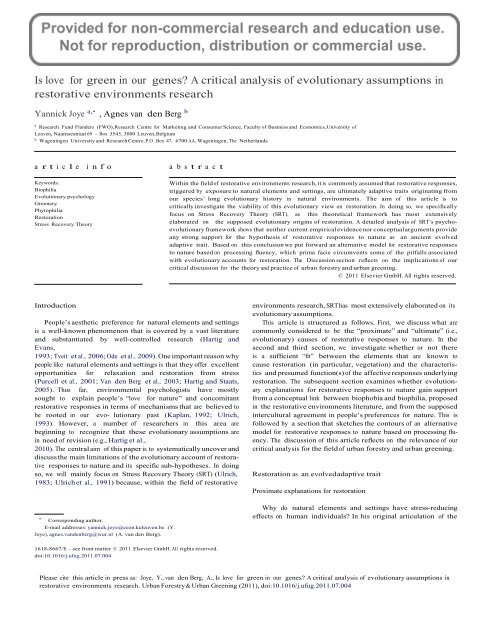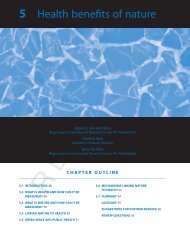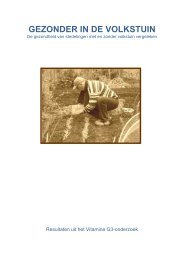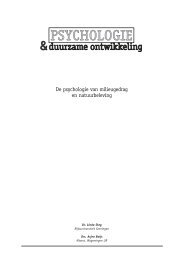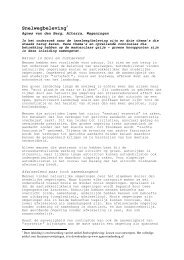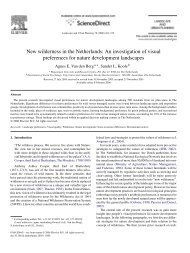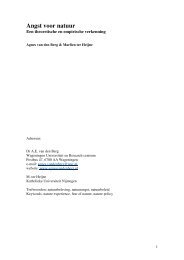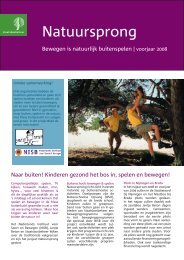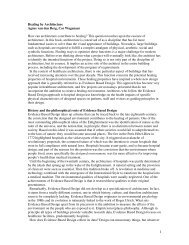Is love for green in our genes? - Agnes van den Berg
Is love for green in our genes? - Agnes van den Berg
Is love for green in our genes? - Agnes van den Berg
- No tags were found...
Create successful ePaper yourself
Turn your PDF publications into a flip-book with our unique Google optimized e-Paper software.
<strong>Is</strong> <strong>love</strong> <strong>for</strong> <strong>green</strong> <strong>in</strong> <strong>our</strong> <strong>genes</strong>? A critical analysis of evolutionary assumptions <strong>in</strong>restorative environments researchYannick Joye a,∗ , <strong>Agnes</strong> <strong>van</strong> <strong>den</strong> <strong>Berg</strong> baResearch Fund Flanders (FWO), Research Centre <strong>for</strong> Market<strong>in</strong>g and Consumer Science, Faculty of Bus<strong>in</strong>ess and Economics, University ofLeuven, Naamsestraat 69 – Box 3545, 3000 Leuven, Belgiumb Wagen<strong>in</strong>gen University and Research Centre, P.O. Box 47, 6700 AA, Wagen<strong>in</strong>gen, The Netherlandsa r t i c l e i n f o a b s t r a c tKeywords:BiophiliaEvolutionary psychologyGreeneryPhytophiliaRestorationStress Recovery TheoryWith<strong>in</strong> the field of restorative environments research, it is commonly assumed that restorative responses,triggered by exposure to natural elements and sett<strong>in</strong>gs, are ultimately adaptive traits orig<strong>in</strong>at<strong>in</strong>g from<strong>our</strong> species’ long evolutionary history <strong>in</strong> natural environments. The aim of this article is tocritically <strong>in</strong>vestigate the viability of this evolutionary view on restoration. In do<strong>in</strong>g so, we specificallyfocus on Stress Recovery Theory (SRT), as this theoretical framework has most extensivelyelaborated on the supposed evolutionary orig<strong>in</strong>s of restoration. A detailed analysis of SRT’s psychoevolutionaryframework shows that neither current empirical evi<strong>den</strong>ce nor conceptual arguments provideany strong support <strong>for</strong> the hypothesis of restorative responses to nature as an ancient evolvedadaptive trait. Based on this conclusion we put <strong>for</strong>ward an alternative model <strong>for</strong> restorative responsesto nature based on process<strong>in</strong>g fluency, which prima facie circumvents some of the pitfalls associatedwith evolutionary accounts <strong>for</strong> restoration. The Discussion section reflects on the implications of <strong>our</strong>critical discussion <strong>for</strong> the theory and practice of urban <strong>for</strong>estry and urban <strong>green</strong><strong>in</strong>g.© 2011 Elsevier GmbH. All rights reserved.IntroductionPeople’s aesthetic preference <strong>for</strong> natural elements and sett<strong>in</strong>gsis a well-known phenomenon that is covered by a vast literatureand substantiated by well-controlled research (Hartig andE<strong>van</strong>s,1993; Tveit et al., 2006; Ode et al., 2009). One important reason whypeople like natural elements and sett<strong>in</strong>gs is that they offer excellentopportunities <strong>for</strong> relaxation and restoration from stress(Purcell et al., 2001; Van <strong>den</strong> <strong>Berg</strong> et al., 2003; Hartig and Staats,2005). Thus far, environmental psychologists have mostlysought to expla<strong>in</strong> people’s “<strong>love</strong> <strong>for</strong> nature” and concomitantrestorative responses <strong>in</strong> terms of mechanisms that are believed tobe rooted <strong>in</strong> <strong>our</strong> evo- lutionary past (Kaplan, 1992; Ulrich,1993). However, a number of researchers <strong>in</strong> this area arebeg<strong>in</strong>n<strong>in</strong>g to recognize that these evolutionary assumptions are<strong>in</strong> need of revision (e.g., Hartig et al.,2010). The central aim of this paper is to systematically uncover anddiscuss the ma<strong>in</strong> limitations of the evolutionary account of restorativeresponses to nature and its specific sub-hypotheses. In do<strong>in</strong>gso, we will ma<strong>in</strong>ly focus on Stress Recovery Theory (SRT) (Ulrich,1983; Ulrich et al., 1991) because, with<strong>in</strong> the field of restorative∗ Correspond<strong>in</strong>g author.E-mail addresses: yannick.joye@econ.kuleuven.be (Y.Joye), agnes.<strong>van</strong><strong>den</strong>berg@wur.nl (A. <strong>van</strong> <strong>den</strong> <strong>Berg</strong>).environments research, SRT has most extensively elaborated on itsevolutionary assumptions.This article is structured as follows. First, we discuss what arecommonly considered to be the “proximate” and “ultimate” (i.e.,evolutionary) causes of restorative responses to nature. In thesecond and third section, we <strong>in</strong>vestigate whether or not thereis a sufficient “fit” between the elements that are known tocause restoration (<strong>in</strong> particular, vegetation) and the characteristicsand presumed function(s) of the affective responses underly<strong>in</strong>grestoration. The subsequent section exam<strong>in</strong>es whether evolutionaryexplanations <strong>for</strong> restorative responses to nature ga<strong>in</strong> supportfrom a conceptual l<strong>in</strong>k between biophobia and biophilia, proposed<strong>in</strong> the restorative environments literature, and from the supposed<strong>in</strong>tercultural agreement <strong>in</strong> people’s preferences <strong>for</strong> nature. This isfollowed by a section that sketches the cont<strong>our</strong>s of an alternativemodel <strong>for</strong> restorative responses to nature based on process<strong>in</strong>g fluency.The discussion of this article reflects on the rele<strong>van</strong>ce of <strong>our</strong>critical analysis <strong>for</strong> the field of urban <strong>for</strong>estry and urban <strong>green</strong><strong>in</strong>g.Restoration as an evolved adaptive traitProximate explanations <strong>for</strong> restorationWhy do natural elements and sett<strong>in</strong>gs have stress-reduc<strong>in</strong>geffects on human <strong>in</strong>dividuals? In his orig<strong>in</strong>al articulation of the1618-8667/$ – see front matter © 2011 Elsevier GmbH. All rights reserved.doi:10.1016/j.ufug.2011.07.004Please cite this article <strong>in</strong> press as: Joye, Y., <strong>van</strong> <strong>den</strong> <strong>Berg</strong>, A., <strong>Is</strong> <strong>love</strong> <strong>for</strong> <strong>green</strong> <strong>in</strong> <strong>our</strong> <strong>genes</strong>? A critical analysis of evolutionary assumptions <strong>in</strong>restorative environments research. Urban Forestry & Urban Green<strong>in</strong>g (2011), doi:10.1016/j.ufug.2011.07.004
ARTICLE IN PRESS2Y. Joye, A. <strong>van</strong> <strong>den</strong> <strong>Berg</strong> / Urban Forestry & Urban Green<strong>in</strong>g xxx (2011) xxx–xxx“psycho-evolutionary framework” underly<strong>in</strong>g SRT, RogerUlrich (1983) ma<strong>in</strong>ly explored the possible proximate causes ofrestoration <strong>in</strong>duced by natural environments. These are theimmediate devel- opmental (ontogenetic) and mechanic causes ofa certa<strong>in</strong> behavi<strong>our</strong> or trait. Based on the empirical work of RobertZajonc (1980), Ulrich (1983) argued that the <strong>in</strong>itial response modeto environments and environmental stimuli is one ofgeneralized affect. Characteris- tic to such affective responses isthat they are deemed to occur almost immediately afterexposure to the stimulus or environ- ment, to require only littlecognitive process<strong>in</strong>g, and to take place without consciousrecognition. This <strong>in</strong>itial affective response mode is believed tohave prehistoric roots and to have been reta<strong>in</strong>ed across thehuman l<strong>in</strong>eage because it contributed to <strong>our</strong> species’ survival.Ulrich (1983, 1986) specified a number of specific environmentalfeatures or “preferenda” that are able to trigger <strong>in</strong>itial positiveaffective responses. These <strong>in</strong>clude “complexity”, “gross structuralfeatures” (e.g., symmetries), “depth/spatiality cues”, “even groundsurface texture”, “deflected vista”, and “absence of threats”. What<strong>in</strong>terests us most, however, is that Ulrich (1983) also conjecturedthat exposure to unthreaten<strong>in</strong>g natural environments or to certa<strong>in</strong>types of unthreaten<strong>in</strong>g natural content (e.g., vegetation) will offsetsuch immediate positive affective responses. When previousto encounters with such natural sett<strong>in</strong>gs/elements an <strong>in</strong>dividualwas <strong>in</strong> a negative mood or experienced stress, then theposi- tive responses <strong>in</strong>duced by nature could attenuate thosenegative feel<strong>in</strong>gs/states, and restoration might follow. Or, assummarized by Ulrich (1983, p. 116): “For <strong>in</strong>dividualsexperienc<strong>in</strong>g stress or anxiety, most unthreaten<strong>in</strong>g naturalviews may be more arousal reduc<strong>in</strong>g and tend to elicit morepositively toned emotional reac- tions than the vast majority ofurban scenes, and hence are more restorative <strong>in</strong> apsychophysiological sense”.Accord<strong>in</strong>g to SRT, restorative responses can thus essentiallybe considered as by-products of immediate positive affectiveresponses <strong>in</strong>duced by (unthreaten<strong>in</strong>g) natural sett<strong>in</strong>gs. Note thatthe centrality of affect <strong>in</strong> SRT marks an important differencewith the other major theory on restorative environments, AttentionRestoration Theory (ART), which assumes that the proximatecause of restoration lies <strong>in</strong> the replenishment of depleted cognitiveres<strong>our</strong>ces (Kaplan and Kaplan, 1989). Of further importance is thatSRT assumes that the l<strong>in</strong>k between positive affect and restorativeresponses is specific to natural environments: “. . . modern humans,as a partly genetic remnant of evolution, have a biologically preparedcapacity <strong>for</strong> acquir<strong>in</strong>g and reta<strong>in</strong><strong>in</strong>g restorative responses tocerta<strong>in</strong> natural sett<strong>in</strong>gs and content . . . but have no such disposition<strong>for</strong> most built environments and their materials” (Ulrich, 1999,p. 52). But why would it have been beneficial <strong>for</strong> humans to evolvesuch a capacity? This question taps <strong>in</strong>to the ultimate or evolutionarycauses of restorative responses to nature, which are the focusof this article.Ultimate explanations of restorative responses to natureDifferent ultimate explanations run through Ulrich’s psychoevolutionaryframework. For example, Ulrich notes that whena stressor has disappeared the <strong>in</strong>ci<strong>den</strong>ce of stress reduction “...would enhance survival chances <strong>in</strong> part because of its role <strong>in</strong>promot<strong>in</strong>g recovery from fatigue and other deleterious effectsstemm<strong>in</strong>g from behav<strong>in</strong>g adaptively <strong>in</strong> a previous demand<strong>in</strong>gsituation” (Ulrich,1993, p. 98). It is <strong>in</strong>deed a well-known fact that after astress- ful episode a failure to return to basel<strong>in</strong>e levels ofarousal may have detrimental health consequences and thusmay have low- ered survival chances (Selye, 1956). While thisaccount perhaps provides an ultimate explanation <strong>for</strong> theprevalence of a general stress reduction response, it must beclear that this is not the type of “restorative” response envisionedby SRT.The central idea underly<strong>in</strong>g SRT is that human <strong>in</strong>dividuals morequickly and more deeply recover from stress near unthreaten<strong>in</strong>gnatural elements and sett<strong>in</strong>gs than near unthreaten<strong>in</strong>g urban environments.As noted earlier, this particular restoration process issupposed to be driven by the differential affective valence of naturalversus urban sett<strong>in</strong>gs. S<strong>in</strong>ce the 1980s there seems to be an(implicit) consensus among restorative environments researchersthat the occurrence of these affective responses is “.. affected byunlearned factors of evolutionary orig<strong>in</strong>” (Ulrich, 1983, p. 115), andthat they need to be considered as remnants of <strong>our</strong> species’ evolution<strong>in</strong> natural environments. Of further importance is that it ismostly assumed that these (positive) affective reactions are evolvedadaptations. Display<strong>in</strong>g such responses to nature fulfilled a particularfunction <strong>in</strong> ancestral environments and “. . . tended to foster[human] survival and well-be<strong>in</strong>g dur<strong>in</strong>g evolution” (Ulrich et al.,1991, p. 209).It must be clear that the <strong>for</strong>ego<strong>in</strong>g account still leaves a numberof questions unanswered. For example, <strong>in</strong> what respect did positiveaffective responses to unthreaten<strong>in</strong>g nature exactly foster survivaldur<strong>in</strong>g <strong>our</strong> species’ evolutionary history? With<strong>in</strong> the restorativeenvironments research field it is generally assumed that some naturalcontent could offer ancestral humans opportunities <strong>for</strong> safety,could conta<strong>in</strong> food res<strong>our</strong>ces, or at least could have been <strong>in</strong>dicativeof the presence of food or safety (cfr., Ulrich et al., 1991, p. 226).Hav<strong>in</strong>g evolved a hardwired ten<strong>den</strong>cy or “preparedness” to displaypositive affective responses to such natural content would have<strong>in</strong>creased ancestral humans’ survival chances because it motivatedthem to pay attention to, or to approach or stay <strong>in</strong> environmentsthat conta<strong>in</strong>ed elements or opportunities that were critical to theirsubsistence (i.e., food and safety).Another issue relates to the type of nature toward which <strong>our</strong>species is supposed to have evolved positive affective responses.Although the empirical and theoretical literature associated withSRT is not very often outspoken on this matter, three general categoriesof “restorative nature” can be i<strong>den</strong>tified. First, on numerousoccasions it is proposed that exposure to unthreaten<strong>in</strong>g naturalsett<strong>in</strong>gs can elicit these immediate positive affective responses.Ulrich (1993, p. 102), <strong>for</strong> example, notes that “[c]onsistent withthe functional-evolutionary perspective . . . view<strong>in</strong>g unthreaten<strong>in</strong>gnatural landscapes tends to promote faster and more completerestoration than . . . urban or built environments”. A second categoryof restorative nature is vegetative elements, or sett<strong>in</strong>gsconta<strong>in</strong><strong>in</strong>g such elements. The reason <strong>for</strong> <strong>in</strong>clud<strong>in</strong>g this categoryderives from the fact that restorative effects are often triggered byvegetated scenes, a f<strong>in</strong>d<strong>in</strong>g that is generally regarded to becon- sistent with, and support<strong>in</strong>g the evolutionary tenets of SRT(cfr., Ulrich et al., 1991). The third and last category of naturalcontent is more specific than the two previous ones, and <strong>in</strong>cludesspecific types of natural sett<strong>in</strong>gs or features that are supposed tofacilitate stress reduction. Ulrich (2008, p. 90) po<strong>in</strong>ts out that thesecan com- prise elements/features like “calm or slowly mov<strong>in</strong>gwater, verdant vegetation, flowers, sa<strong>van</strong>na-like or parklikeproperties. . .”.Based on the previous discussion, SRT’s ultimate account <strong>for</strong>restorative responses to nature can be summarized as follows.A biologically prepared read<strong>in</strong>ess to display positive affectiveresponses to different types of unthreaten<strong>in</strong>g natural content isan evolved adaptive mechanism (Ulrich, 2008, p. 89), whose functionwas to guide and support <strong>our</strong> ancestors <strong>in</strong> the processof f<strong>in</strong>d<strong>in</strong>g food, water and shelter <strong>in</strong> ancestral environments.When hav<strong>in</strong>g experienced a stressful episode, exposure to naturalcontent provid<strong>in</strong>g food/water/shelter can lead to stress reductionvia the (psychologically and physiologically) sooth<strong>in</strong>g effects ofpositive affect (Ulrich, 2008). The fact that, on an evolutionarytime-scale, <strong>our</strong> species has only recently begun to construct and<strong>in</strong>habit built environments, but has experienced the “.. rewardsassociated with natural sett<strong>in</strong>gs dur<strong>in</strong>g a few million years ofevolution” (Ulrich
ARTICLE IN PRESSY. Joye, A. <strong>van</strong> <strong>den</strong> <strong>Berg</strong> / Urban Forestry & Urban Green<strong>in</strong>g xxx (2011) xxx–xxx 5vegetated sett<strong>in</strong>gs. That prediction has, however, not received anystrong empirical confirmation. This warrants at least some reconsiderationof SRT’s evolutionary commitments.Response characteristics of the PRMThe overall conclusion from the previous discussion is that thereappears to be a mismatch between the possible <strong>in</strong>put categories ofthe PRM (e.g., sa<strong>van</strong>nah-type landscapes) and the function of thePRM (e.g., facilitat<strong>in</strong>g food acquisition). On the one hand, the proposed<strong>in</strong>put of the PRM seems too coarse to fulfil the function ofthe PRM (see the first two parts of the above section), while on theother hand, hypotheses regard<strong>in</strong>g very specific types of <strong>in</strong>put ofthe PRM are (still) not, or <strong>in</strong>sufficiently supported by the empiricalfacts (third part of above section). In the follow<strong>in</strong>g sections somefurther mismatches/tensions between the (response) characteristicsof the PRM and its functions will be discussed. Note that thesetensions predom<strong>in</strong>antly arise when the characteristics of the PRMare confronted with the category “unthreaten<strong>in</strong>g vegetative elements/sett<strong>in</strong>gs”(cfr., second part of above section). This, however, isthe category of natural content that consistently comes out ashav<strong>in</strong>g high(est) restorative potential <strong>in</strong> restorative environmentsresearch.Why fast?Accord<strong>in</strong>g to SRT restorative responses will occur very rapidlyafter exposure to unthreaten<strong>in</strong>g natural sett<strong>in</strong>gs and elements,which is a prediction that has also been empirically confirmed(e.g., Ulrich et al., 1991; Korpela et al., 2002). We arehowever confused about how this established f<strong>in</strong>d<strong>in</strong>g fits with<strong>in</strong> apsycho- evolutionary framework <strong>for</strong> restoration. Specifically, wedo not understand why rapid responses should be a necessaryfeature of a mechanism that (supposedly) evolved to facilitate theprocess of food acquisition. The claim <strong>for</strong> rapidity seems to implythat slower or delayed responses toward nature, and specificallytoward veg- etative life would have had significant fitness costs,because they would have made the process of acquir<strong>in</strong>g foodstuffsuboptimal or even unsuccessful. Natural elements likevegetation are how- ever often fairly conspicuous and mostlyvisible from significant distances. Vegetative life does not quicklychange location, nor does its overall shape and contents (e.g.,fruits) change or appear over an <strong>in</strong>stant. This given – and keep<strong>in</strong>g <strong>in</strong>m<strong>in</strong>d one of the ma<strong>in</strong> functions of the PRM, i.e., food acquisition –it needs to be further elucidated why there should have been aselection pressure to evolve very rapid affective responsestoward <strong>green</strong>ery. It seems to make more sense to claim that suchrapid positive responses are required <strong>for</strong> vegetative elements as“emergency escape routes” or as “refuges” from immediatethreats. However, the problem with this proposal is that it aga<strong>in</strong>bur<strong>den</strong>s us with the issue already discussed above, namely thequestion of why restoration needs to be situated at the level of thecategory vegetative elements.Why affective?Another feature assumed to be central to restorative responsesto (non-threaten<strong>in</strong>g) natural stimuli is their affective immediacy.Accord<strong>in</strong>g to Ulrich (1983) immediate affective responses actto motivate <strong>in</strong>dividuals to undertake adaptive actions vis-à-vis acer- ta<strong>in</strong> natural stimulus or environment. For example, <strong>in</strong> theface of a threat, such as a snake, an <strong>in</strong>itial negative affectiveresponse motivated flight or freeze behavi<strong>our</strong>, whereas a positiveaffective reaction to – say – a group of verdant trees mighthave moti- vated approach<strong>in</strong>g and explorative behavi<strong>our</strong>, andas such, may have <strong>in</strong>creased survival chances. But as alreadymentioned ear- lier, one can safely assume that humans havealways <strong>in</strong>habitedmore or less vegetated environments, perhaps with theexcep- tion of deserts. Because a certa<strong>in</strong> amount of vegetationthus was always present, <strong>in</strong>dividuals with an evolvedread<strong>in</strong>ess to dis- play positive affect toward <strong>green</strong>ery had nomore easy access to <strong>green</strong>ery, and thus to its benefits, thanthose not shar<strong>in</strong>g this predisposition. But why should affectthen be so essential to <strong>our</strong> supposedly “evolved” response modeto this category of natu- ral stimuli? This problem not onlyposes itself if we assume that positive affect is displayed to<strong>green</strong>ery <strong>in</strong> general, but also to par- ticular landscape-types. Ifthe African sa<strong>van</strong>nah <strong>in</strong>deed was the natural décor dur<strong>in</strong>gmost of <strong>our</strong> species’ evolutionary history, which adaptive rolecould positive affective responses towards such environmentsthen have played? After all, this type of biome was <strong>our</strong> “natural”habitat, mak<strong>in</strong>g it unclear why there should have been anyfurther need <strong>for</strong> affect to motivate to explorative orapproach<strong>in</strong>g behavi<strong>our</strong>. Aga<strong>in</strong> it needs to be further clarifiedwhy a central characteristic of the PRM, that is, the centrality ofaffect, is necessary to per<strong>for</strong>m its function (i.e., acquir<strong>in</strong>g food andsafety).Why ancient?Modern urban environments provide us ample opportunities<strong>for</strong> obta<strong>in</strong><strong>in</strong>g food and possibilities <strong>for</strong> shelter. But if theserela- tively new environments can easily solve problems <strong>for</strong>which the PRM is assumed to have been designed, why is itstill the case that nature is predom<strong>in</strong>antly more restorativethan urban envi- ronments? The answer that can be derivedfrom SRT is that this is because we are equipped with “stoneage”bra<strong>in</strong>s, and too lit- tle time has passed <strong>for</strong> <strong>our</strong> cognitivearchitecture to adapt to, and to be moulded by the new urbansituation. This assumption, also known as the “adaptive lag”hypothesis (Laland and Brown, 2006), is however controversialand recently it has even been acknowl- edged as such byrestorative environments researchers (cfr., Hartig et al., 2010). Asthe case of – <strong>for</strong> example – lactose tolerance <strong>in</strong> cer- ta<strong>in</strong> worldpopulations illustrates, adaptive traits can develop at a fairly fastrate and it should not be a priori excluded that restora- tiveresponses are fairly recent adaptations. In other words, it seems thatthe proposed function of the PRM (i.e., food and shelter) does notrequire it to be an ancient mechanism. Given the fact that explanations<strong>in</strong> terms of ancient adaptations show clear shortcom<strong>in</strong>gs,as demonstrated by <strong>our</strong> critical review thus far, the idea of restorationas a relatively recent adaptation deserves at least some furtherconsideration.Arguments <strong>in</strong> fav<strong>our</strong> of the evolutionary assumptions of SRTIn the previous sections we have attempted to reveal a numberof tensions between the adaptive function of the PRM on theone hand (as portrayed by SRT) and the characteristic properties ofrestorative responses to nature and the stimuli which cause suchresponses on the other hand. While these tensions suggest that weare still <strong>in</strong> the dark as to whether or not restorative responses havean adaptive function, that <strong>in</strong> itself does not preclude an evolutionaryexplanation <strong>for</strong> restoration. It is, <strong>for</strong> example, entirely possiblethat restorative responses to nature have another adaptive functionthan the one proposed <strong>in</strong> SRT’s psycho-evolutionary framework,or perhaps such responses are evolved, but non-adaptivetraits, much like male nipples are. In the sections that follow we setaside the issue of adaptive function and rather focus on the moregen- eral question whether there is sufficient ground to concludethat restorative responses to nature are a universally shared,evolved human trait. Specifically we will review two argumentswhich have been put <strong>for</strong>ward <strong>in</strong> the restorative environmentsliterature to back up the claim <strong>for</strong> of the evolved nature ofrestorative responses.
RESS6 Y. Joye, A. <strong>van</strong> <strong>den</strong> <strong>Berg</strong> / Urban Forestry & Urban Green<strong>in</strong>g xxx (2011) xxx–xxxIntercultural agreement po<strong>in</strong>ts to universalityA first argument starts from the observation that research<strong>in</strong> different countries reveals substantial <strong>in</strong>tercultural agreement<strong>in</strong> preferences <strong>for</strong> natural environments. Based on thisobservation, it is stated that positive affective responses to natureare universally shared, which renders evolutionary explanations ofsuch responses more plausible than cultural and personallearn<strong>in</strong>g perspectives (e.g., Ulrich, 1993, p. 97). One difficultywith this argument <strong>for</strong> universality is that it relies almostexclusively on research on (fairly elaborate) aestheticpreferences <strong>for</strong> nature, which, as we have expla<strong>in</strong>ed be<strong>for</strong>e,probably tap <strong>in</strong>to different processes than restorative responses.Another difficulty is that the available cross- cultural research doesnot seem to cover the full breadth of human diversity. Specifically,(Lewis, 2005, p. 90) notes that populations that are the subject ofmany preferential studies are often histor- ically and ethnicallyrelated (e.g., Americans vs. Australians), and those who are not aremostly still urban or suburban resi<strong>den</strong>ts, with highly similar natureexperiences. A notable exception seems to be the recent Falk andBall<strong>in</strong>g (2010) study, which found that Nigerian subjects who areunacqua<strong>in</strong>ted with sa<strong>van</strong>nahs prefer this type of biome, overother (more familiar) biomes. Accord<strong>in</strong>g to Falk and Ball<strong>in</strong>g thisreplication of their earlier results (see Ball<strong>in</strong>g and Falk,1982, p. 11) with non-western <strong>in</strong>dividuals suggests that <strong>our</strong> species“.. . beg<strong>in</strong>[s] life with a preference <strong>for</strong> sa<strong>van</strong>na-like environments”.While the available cross-cultural research unquestionably yieldsvaluable <strong>in</strong>sights, much more research with non-western(ized)samples and more direct measures of restoration are neededbe<strong>for</strong>e a claim to universality of restorative responses can bejustified.Biophobia supports phytophiliaA second argument, put <strong>for</strong>ward by Ulrich (1993), starts off fromthe claim that <strong>our</strong> evolved human nature conta<strong>in</strong>s defence mechanismsaga<strong>in</strong>st certa<strong>in</strong> natural threats, such as snakes or spiders.Based on the assumption that such “biophobic” responses constituteonly one half of a “‘symmetric’ biophobia/biophilia framework”(Ulrich, 1993, p. 88), Ulrich concludes that natural selection mustalso have endowed humans with mechanisms that make themrespond positively to natural entities that were beneficial to theirreproductive fitness. In a nutshell, Ulrich believes that proposals <strong>for</strong>an <strong>in</strong>nate predisposition <strong>for</strong> (among others) phytophilia “. . . ga<strong>in</strong>plausibility and consistency if they also postulate a correspond<strong>in</strong>ggenetic predisposition <strong>for</strong> adaptive biophobic responses to certa<strong>in</strong>natural stimuli that presumably have constituted survival-relatedthreats throughout human evolution (Ulrich, 1993, p. 75).We th<strong>in</strong>k that the previous argument is flawed <strong>for</strong> two reasons.First, it needs to be kept <strong>in</strong> m<strong>in</strong>d that the extent to which biophobicresponses are actually “hardwired” is still debated (e.g., Blanchette,2006). By extension, one should be careful about consider<strong>in</strong>gpositive affective responses to <strong>green</strong>ery as <strong>in</strong>nate or biologicallyprepared, especially s<strong>in</strong>ce biophobic responses are explicitly studiedto shed light on their possible evolved orig<strong>in</strong>s, while thisis not, or only marg<strong>in</strong>ally the case <strong>for</strong> the <strong>for</strong>mer (cfr., M<strong>in</strong>ekaand Öhman, 2002). A second issue is that there probably is nosuch th<strong>in</strong>g as a “‘symmetric’ biophobia/biophilia framework”. Itrather seems to be the case that organisms are predom<strong>in</strong>antlydisposed to be hardwired to attend to and respond to threaten<strong>in</strong>grather than to nonthreaten<strong>in</strong>g stimuli/situations. This is becausefail<strong>in</strong>g to negoti- ate encounters with negative events/elementswill have had much higher fitness costs (i.e., death) than fail<strong>in</strong>g tonegotiate encoun- ters with positive elements/events(Baumeister et al., 2001). This “negativity bias” <strong>in</strong> evolution thusunderm<strong>in</strong>es the claim that the existence of a PRM ga<strong>in</strong>splausibility from the existence of <strong>in</strong>nate biophobic responses.But suppose, <strong>for</strong> the sake of the argument, that there<strong>in</strong>deed is a symmetric biophobia/biophilia framework and thatbiophobic responses are truly hardwired. Even then, it still needs tobe further expla<strong>in</strong>ed and empirically justified why specificallyphytophilic responses – and not some other type of positiveresponse to nature– constitute the symmetric counterpart of biophobicresponses. As should have become clear from the previoussections, current empirical research and theoretical argumentsstruggle to provide such a justification. It appears that the“biophobia means biophilia argument” can barely provide anyadditional support <strong>for</strong> the via- bility of the hardwired character ofthe PRM (see also: Joye and De Block, 2011 <strong>for</strong> a lengthierexposition of this specific argument).Restorative responses to nature and perceptual fluencyAs discussed <strong>in</strong> the <strong>in</strong>troductory sections of this paper, SRT’s coreassumption is that phytophilic elements can quickly offset positiveaffective responses, which are able to attenuate stress. While <strong>in</strong>SRT’s psycho-evolutionary framework such positive responses aredeemed to be adaptive remnants of human evolution <strong>in</strong> naturalenvironments, we hope to have demonstrated that this evolutionaryaccount has clear shortcom<strong>in</strong>gs. It should yet be granted toUlrich that his psycho-evolutionary account of restoration at leastconstitutes an attempt to provide a detailed answer to the questionof why restorative responses to nature ultimately occur. Thiscontrasts, <strong>for</strong> example, with Stephen Kaplan’s rather crude viewon the ultimate orig<strong>in</strong>s of restoration: “The way I th<strong>in</strong>k of it is that<strong>our</strong> ancestors evolved <strong>in</strong> a nature-filled environment.. [and that, asa result, such places] should feel more com<strong>for</strong>table, more relaxed,more like home” (cited <strong>in</strong>: Jaffe, 2010, p. 12). Instead of such generalstatements, we are <strong>in</strong> need of a f<strong>in</strong>e-gra<strong>in</strong>ed causal accountthat actually addresses the question of how restorative responsescome about.One of the authors of the current article has tried to tackle thequestion of why unthreaten<strong>in</strong>g environments trigger positive affectiveresponses by relat<strong>in</strong>g such responses to research on process<strong>in</strong>gfluency (Joye, 2007). Process<strong>in</strong>g fluency is commonly def<strong>in</strong>ed as thesubjective experience of the ease with which a certa<strong>in</strong> stimulusorganization is processed. Research shows that fluent process<strong>in</strong>gis commonly accompanied by positive affect, which is af<strong>in</strong>d<strong>in</strong>g that is ascribed to the fact that fluency po<strong>in</strong>ts out that“good” and efficient stimulus process<strong>in</strong>g is tak<strong>in</strong>g place or thatsufficient cog- nitive res<strong>our</strong>ces are available to deal with a certa<strong>in</strong>stimulus (Reber et al., 2004). Build<strong>in</strong>g on this fluency literature, thePerceptual Flu- ency Account (PFA) of restoration states thatunthreaten<strong>in</strong>g natural scenes are affectively evaluated morepositively than unthreaten- <strong>in</strong>g urban scenes because <strong>our</strong> visualsystem more fluently processes certa<strong>in</strong> aspects of the visualstructure of the <strong>for</strong>mer than of the lat- ter (see also Redies, 2007).Accord<strong>in</strong>g to PFA, restoration is – much like <strong>in</strong> SRT – the result of an“undo<strong>in</strong>g process” <strong>in</strong>itiated by positive affect, but <strong>in</strong> the case ofPFA the affective response is due to fluent process<strong>in</strong>g rather than toobscure evolutionary factors. Because PFA posits a process<strong>in</strong>gad<strong>van</strong>tage of natural/<strong>green</strong> sett<strong>in</strong>gs over urban scenes, it expectsthat process<strong>in</strong>g the <strong>for</strong>mer will require less cog- nitive res<strong>our</strong>cesthan the latter, which con<strong>for</strong>ms to the f<strong>in</strong>d<strong>in</strong>g that exposure tonature is superior <strong>in</strong> counteract<strong>in</strong>g attention depletion than urbanscenes (Kaplan and Kaplan, 1989).In a nutshell, PFA views attention restoration and stress reduction(to a considerable extent) as by-products of fluent process<strong>in</strong>g.This theoretical account should, however, not be considered as a“paradigm shift” <strong>in</strong> restorative environments research. The accountrather br<strong>in</strong>gs ideas to the <strong>for</strong>eground, which have been present<strong>in</strong> this field of research <strong>for</strong> quite some time, and it relatesthem to research on process<strong>in</strong>g fluency. For example, the coreidea of PFA is already present <strong>in</strong> ART, where the restorativeconstruct
ARTICLE IN PRESSY. Joye, A. <strong>van</strong> <strong>den</strong> <strong>Berg</strong> / Urban Forestry & Urban Green<strong>in</strong>g xxx (2011) xxx–xxx 7of “fasc<strong>in</strong>ation” (Kaplan and Kaplan, 1989) is commonly equatedwith ef<strong>for</strong>tless process<strong>in</strong>g. Similarly, Ulrich et al. (1991, p. 205)have briefly alluded to ease of process<strong>in</strong>g when they discuss theview “. . . that natural content may be processed with relative easeand efficiency because the bra<strong>in</strong> and sensory systems evolved <strong>in</strong>natural environments”. Note that there already is some support<strong>in</strong>gevi<strong>den</strong>ce <strong>for</strong> PFA. For example, natural scenes are found tobe categorized faster than artefactual scenes, which is consistentwith the view of a fluency ad<strong>van</strong>tage of the <strong>for</strong>mer over the latter(e.g., Greene and Oliva, 2009). Fluency and cod<strong>in</strong>g efficiencyhave recently also been <strong>in</strong>quired by restorative environmentsresearchers and the first results appear to be consistent with PFA(T<strong>in</strong>io, 2010).One of the ma<strong>in</strong> challenges <strong>for</strong> PFA is to p<strong>in</strong>po<strong>in</strong>t exactly which(visual) features make natural scenes more fluent than urbanscenes. One proposal is based on the f<strong>in</strong>d<strong>in</strong>g that natural environmentsare often experienced as be<strong>in</strong>g more coherent than the urbanscenes with which they are compared <strong>in</strong> restorative environmentsstudies (Kaplan and Kaplan, 1989). We conjecture that the higherperceived visual coherence of natural scenes makes that they areexperienced as more fluent than their urban counterparts, whichcontributes to the difference <strong>in</strong> restorativeness between both scenetypes. We furthermore believe that this coherence of natural scenesis at least partly related to nature’s so-called “fractal” characteristics(Purcell et al., 2001; Joye, 2007). The notion “fractal” is a mathematicalconcept that is used to describe the mathematical “language”underly<strong>in</strong>g (the visual aspects of) natural <strong>for</strong>ms and processes. Thefractality of natural environments and elements is – among others– clear from the fact that such shapes/scenes consist of <strong>in</strong>creas<strong>in</strong>glysmaller copies of themselves over a large number of scales of magnitude.For example, <strong>in</strong> a tree, all the branches – from big to small– are scaled-down versions of the entire tree. This property is alsoknown as “self-similarity” and it makes that <strong>in</strong> nature one part of ascene already gives an idea of what is “go<strong>in</strong>g on” <strong>in</strong> other parts ofthe scene. In other words, natural environments are often characterizedby a deep degree of perceptual predictability/redundancy,whereas urban scenes often tend to consist of perceptually divergentobjects/processes, which compete <strong>for</strong> visual attention andthere<strong>for</strong>e make the scene substantially less easy to grasp and process.The idea that fractality is a determ<strong>in</strong>ant of people’s responsesto nature has already received some prelim<strong>in</strong>ary support. For example,Hagerhall et al. (2004) found that preference responses tonatural scenes can be predicted by their fractal characteristics.DiscussionWe would like to highlight the rele<strong>van</strong>ce of <strong>our</strong> discussion <strong>for</strong>the field of urban <strong>for</strong>estry and urban <strong>green</strong><strong>in</strong>g. Specifically, it hasbeen argued that because people have <strong>in</strong>creas<strong>in</strong>gly less opportunities<strong>for</strong> nature-contact <strong>in</strong> modern urban sett<strong>in</strong>gs, they are becom<strong>in</strong>gdeprived of the possibility to experience nature’s psychologicaland health-related benefits (Van <strong>den</strong> <strong>Berg</strong> et al., 2007). Based onthis, f<strong>in</strong>d<strong>in</strong>gs from restoration studies may offer landscape plannersand architects a much-wanted psychological justification <strong>for</strong><strong>green</strong> <strong>in</strong>terventions <strong>in</strong> urban and peri-urban areas. But how does<strong>our</strong> theoretical discussion relate to the practice of urban<strong>green</strong>- <strong>in</strong>g? We are concerned that by embrac<strong>in</strong>g narrowevolutionary assumptions, the entire research field of restorationstudies might all too hastily become refuted or marg<strong>in</strong>alized bycritics who do not subscribe to the value of restorative<strong>in</strong>terventions, and that this, <strong>in</strong> turn, will hamper the process ofurban <strong>green</strong><strong>in</strong>g. A criti- cal attitude toward prevalentevolutionary ideas, comb<strong>in</strong>ed with a better <strong>in</strong><strong>for</strong>med <strong>in</strong>sight <strong>in</strong>tothe specific mechanisms that lead to restoration, might provide amore solid theoretical basis <strong>for</strong> <strong>green</strong> <strong>in</strong>terventions, and might takeaway reluctance to be associated with the field of restorativeenvironments research.Another reason why we th<strong>in</strong>k <strong>our</strong> discussion is rele<strong>van</strong>t to urban<strong>for</strong>estry and urban <strong>green</strong><strong>in</strong>g is that the evolutionary assumptionswhich were considered <strong>in</strong> this article have guided, implicitly aswell as explicitly, the restorative environments research agenda.When it is taken <strong>for</strong> granted that restoration is an ancient adaptiveresponse, researchers might (quite understandably) not be verykeen on explor<strong>in</strong>g hypotheses that run aga<strong>in</strong>st that evolutionaryview. Go<strong>in</strong>g beyond the prevalent nature-urban dichotomy thatis associated with SRT’s evolutionary framework might howeverreveal that not only pure <strong>green</strong> <strong>in</strong>terventions, but also a mixof urban and natural environmental features can promoterestora- tion. If true, the question of how to successfullymerge nature and urban elements deserves furtherconsideration (Joye, 2007). In addition, SRT’s psychoevolutionaryframework seems to sug- gest that the restorativeeffects of <strong>green</strong> <strong>in</strong>terventions are largely <strong>in</strong>depen<strong>den</strong>t from localand cultural contexts. As we have argued, this could well be anartefact of the fact that restoration research has thus far ma<strong>in</strong>lyfocused on samples of higher-educated west- ern(ized) urbanites.We are conv<strong>in</strong>ced that the research field of urban <strong>for</strong>estry andurban <strong>green</strong><strong>in</strong>g can further chart <strong>in</strong>dividual differences <strong>in</strong>respond<strong>in</strong>g to nature and that by transcend<strong>in</strong>g the almosttraditional urban-nature dichotomy it will play a pioneer<strong>in</strong>g role <strong>for</strong>the field of restorative environments research.The assumption that restorative responses to nature are anadaptive remnant of <strong>our</strong> species’ shared evolutionary history <strong>in</strong>natural environments has dom<strong>in</strong>ated research <strong>in</strong> environmentalpsychology s<strong>in</strong>ce the 1980s. For a long time, this view has rema<strong>in</strong>edlargely unquestioned. Possibly, this status quo has (partially) beenfuelled by the concern that we would lose an argument <strong>for</strong> naturepreservation if it would turn out that positive human affective attitudesto nature are not driven by a deeply engra<strong>in</strong>ed connectionwith nature (Wilson, 1984), but are the result of more malleablecultural dispositions. Despite its critical tone, the current reviewhas been guided by a genu<strong>in</strong>e concern <strong>for</strong> the future development ofthe field of restorative environments studies. Rather than th<strong>in</strong>k<strong>in</strong>gthat <strong>our</strong> discussion limits this research field, we hope and anticipatethat it will open up new avenues of empirical as well astheoretical research. We want to emphasize that the key theorieson restora- tion (i.e., SRT and ART) are still highly rele<strong>van</strong>t, despitethe fact that they leave certa<strong>in</strong> questions unanswered. Forexample, the alterna- tive account <strong>for</strong> restoration which we brieflytouched upon <strong>in</strong> this paper (PFA), further builds on, and implementsconstructs that play a key-role <strong>in</strong> SRT and ART, such as positiveaffect and ef<strong>for</strong>tlessness.AcknowledgmentsMany thanks to Terry Hartig, Maarten Jacobs, Jan Verpooten andSiegfried Dewitte and to the two anonymous reviewers <strong>for</strong> helpfulcomments and suggestions on this paper. This paper was supportedby the Research Foundation – Flanders (FWO).ReferencesAppleton, J., 1975. The Experience of Landscape. Wiley, London.Ball<strong>in</strong>g, J.D., Falk, J.H., 1982. Development of visual preference <strong>for</strong> natural environments.Environment and Behavior 14, 5–28.Baumeister, R.F., Bratslavsky, E., F<strong>in</strong>kenauer, C., Vohs, K.D., 2001. Bad is stronger thangood. Review of General Psychology 5, 323–370.Biederman, I., Vessel, E.A., 2006. Perceptual pleasure and the bra<strong>in</strong>. American Scientist94, 249–255.Blanchette, I., 2006. Snakes, spiders, guns, and syr<strong>in</strong>ges: how specific are evolutionaryconstra<strong>in</strong>ts on the detection of threaten<strong>in</strong>g stimuli? Quarterly J<strong>our</strong>nal ofExperimental Psychology 59, 1484–1504.Falk, J.H., Ball<strong>in</strong>g, J.D., 2010. Evolutionary <strong>in</strong>fluence on human landscape preference.Environment and Behavior 42, 479–493.Frumk<strong>in</strong>, H., 2001. Beyond toxicity. Human health and the naturalenvironment.American J<strong>our</strong>nal of Preventive Medic<strong>in</strong>e 20, 234–240.Greene, M.R., Oliva, A., 2009. The briefest of glances: the time c<strong>our</strong>se of natural sceneunderstand<strong>in</strong>g. Psychological Science 20, 464–472.
ARTICLE IN PRESS8 Y. Joye, A. <strong>van</strong> <strong>den</strong> <strong>Berg</strong> / Urban Forestry & Urban Green<strong>in</strong>g xxx (2011) xxx–xxxGr<strong>in</strong>de, B., Patil, G.G., 2009. Biophilia: does visual contact with nature impacton health and well-be<strong>in</strong>g? International J<strong>our</strong>nal of Environmental Researchand Public Health 6, 2332–2343.Hagerhall, C.M., Purcell, T., Taylor, R., 2004. Fractal dimension of landscape silhouetteoutl<strong>in</strong>es as a predictor of landscape preference. J<strong>our</strong>nal of EnvironmentalPsychology 24, 247–255.Han, K.-T., 2007. Responses to six major terrestrial biomes <strong>in</strong> terms of scenic beauty,preference, and restorativeness. Environment and Behavior 39, 529–556.Hartig, T., E<strong>van</strong>s, G.W., 1993. Psychological foundations of nature experience.In: Gärl<strong>in</strong>g, T., Golledge, R.G. (Eds.), Behavior and Environment: Psychologicaland Geographical Approaches. , Elsevier/North-Holland, Amsterdam, pp. 427–457.Hartig, T., Staats, H., 2005. L<strong>in</strong>k<strong>in</strong>g preference <strong>for</strong> environments with their restorativequality. In: Tress, B., Tress, G., Fry, G., Opdam, P. (Eds.), FromLandscape Research to Landscape Plann<strong>in</strong>g: Aspects of Integration, Educationand Applica- tion. Spr<strong>in</strong>ger, Dordrecht, pp. 279–292.Hartig, T., Van <strong>den</strong> <strong>Berg</strong>, A.E., Hagerhall, C.M., Tomalak, M., Bauer, N.,Hansmann, R., Ojala, A., Syngollitou, E., Carrus, G., Van Herzele, A., Bell, S.,Podesta, M.T.C., Waaseth, G., 2010. Health benefits of nature experience:psychological, social and cultural processes. In: Nilsson, K., Sangster, M., Gallis,C., et, al. (Eds.), Forests, Trees and Human Health. Spr<strong>in</strong>ger Science Bus<strong>in</strong>ess andMedia, Dordrecht, pp.127–168.Hartmann, P., Apaolaza-Ibáñ ez, V., 2009. Beyond Sa<strong>van</strong>na: An evolutionary an<strong>den</strong>vi- ronmental psychology approach to behavioral effects of nature scenery <strong>in</strong><strong>green</strong> advertis<strong>in</strong>g. J<strong>our</strong>nal of Environmental Psychology 30, 119–128.Haviland-Jones, J., Rosario, H.H., Wilson, P., McGuire, T.R., 2005. Anenviron- mental approach to positive emotion: flowers. EvolutionaryPsychology 3,104–132.Heerwagen, J.H., Orians, G.H., 1993. Humans, habitats, and aesthetics. In:Kellert, S.R., Wilson, E.O. (Eds.), The Biophilia Hypothesis. <strong>Is</strong>land Press,Wash<strong>in</strong>gton, pp.138–172.Herzog, T.R., Rector, A.E., 2009. Perceived danger and judged likelihood of restoration.Environment and Behavior 41, 387–401.Jaffe, E., 2010. This side of paradise. Why the human m<strong>in</strong>d needs nature. APS Observer23, 10–15.Joye, Y., 2007. Architectural lessons from environmental psychology: the caseof biophilic architecture. Review of General Psychology 11, 305–328.Joye, Y., De Block, A., 2011. ‘Nature and I are two’. A critical analysis of the biophiliahypothesis. Environmental Values 20, 189–215.Kaplan, R., Kaplan, S., 1989. The Experience of Nature: A Psychological Perspective.Cambridge University Press, Cambridge.Kaplan, S., 1992. Environmental preference <strong>in</strong> knowledge-seek<strong>in</strong>g, knowledge-us<strong>in</strong>gorganism. In: Barkow, J., Cosmides, L., Tooby, J. (Eds.), The Adapted M<strong>in</strong>d. Ox<strong>for</strong>dUniversity Press, Ox<strong>for</strong>d, pp. 581–598.Korpela, K.M., Klemettilä, T., Hietanen, J.K., 2002. Evi<strong>den</strong>ce <strong>for</strong> rapid affective evaluationof environmental scenes. Environment & Behavior 34, 634–650.Kuo, F.E., 2001. Cop<strong>in</strong>g with poverty: impacts of environment and attention <strong>in</strong> the<strong>in</strong>ner city. Environment & Behavior 33, 5–34.Laland, K.N., Brown, G.R., 2006. Niche construction, human behavi<strong>our</strong> and the adaptivelag hypothesis. Evolutionary Anthropology 15, 95–104.Lewis, J., 2005. Challenges of <strong>in</strong>terdiscipl<strong>in</strong>arity <strong>for</strong> <strong>for</strong>est management andland- scape perception research. In: Tress, B., Tress, G., Fry, G., et, al.(Eds.), From Landscape Research to Landscape Plann<strong>in</strong>g: Aspects of Integration,Education, and Application. Spr<strong>in</strong>ger, Dordrecht, pp. 83–94.Lohr, V.I., 2007. Benefits of nature: what we are learn<strong>in</strong>g about why people respondto nature. J<strong>our</strong>nal of Physiological Anthropology 26, 83–85.Lohr, V.I., Pearson-Mims, C.H., 2006. Responses to scenes with spread<strong>in</strong>g, roundedand conical tree <strong>for</strong>ms. Environment & Behavior 38, 667–688.Lyons, E., 1983. Demographic correlates of landscape preference. Environment andBehavior 15, 487–511.Martens, D., Gutscher, H., Bauer, N., 2010. Walk<strong>in</strong>g <strong>in</strong> “wild” and “tended”urban <strong>for</strong>ests: the impact on psychological well-be<strong>in</strong>g. J<strong>our</strong>nal ofEnvironmental Psy- chology 31, 36–44.M<strong>in</strong>eka, S., Öhman, A., 2002. Phobias and preparedness: the selective,automatic, and encapsulated nature of fear. Biological Psychiatry 52, 927–937.Ode, Å., Fry, G., Tveit, M.S., Messager, P., Miller, D., 2009. Indicators ofperceived naturalness as drivers of landscape preference. J<strong>our</strong>nal ofEnvironmental Man- agement 90, 375–383.Parsons, R., Tass<strong>in</strong>ary, L.G., Ulrich, R.S., Hebl, M.R., Grossman-Alexander, M., 1998.The view from the road: implications <strong>for</strong> stress recovery andimmunization. J<strong>our</strong>nal of Environmental Psychology 18, 113–140.Purcell, T., Peron, E., Berto, R., 2001. Why do preferences differ between scene types?Environment and Behavior 33, 93–106.Reber, R., Schwarz, N., W<strong>in</strong>kielman, P., 2004. Process<strong>in</strong>g fluency and aesthetic pleasure:is beauty <strong>in</strong> the perceiver’s process<strong>in</strong>g experience? Personality and SocialPsychology Review 8, 364–382.Redies, C., 2007. A universal model of esthetic perception based on thesensory cod<strong>in</strong>g of natural stimuli. Spatial Vision 21, 97–117.Selye, H., 1956. The Stress of Life. McGraw Hill, New York.Sulli<strong>van</strong>, W.C., 2003. The sa<strong>van</strong>na and the city: nature at home. In: Barlett,P. (Ed.), Urban Place: Reconnections with the Natural World. AcademicExchange, Atlanta, pp. 55–63.T<strong>in</strong>io, P., 2010. Visual Features, Aesthetic Judgments, and Modulat<strong>in</strong>gFac- tors. Vienna. Unpublished doctoral thesis. Retrieved on 06.10.10from http://othes.univie.ac.at/9137/1/2010-01-28 0605023.pdf.Todorova, A., Asakawa, S., Aikoh, T., 2004. Preferences <strong>for</strong> and attitudestowards street flowers and trees <strong>in</strong> Sapporo, Japan. Landscape and UrbanPlann<strong>in</strong>g 69,403–416.Tooby, J., Cosmides, L., 1992. The psychological foundations of culture. In: Barkow,J.H., Cosmides, L., Tooby, J. (Eds.), The Adapted M<strong>in</strong>d. Evolutionary Psychologyand the Generation of Culture. Ox<strong>for</strong>d University Press, New York, pp. 19–136.Tveit, M., Ode, Å., Fry, G., 2006. Key concepts <strong>in</strong> a framework <strong>for</strong> analyz<strong>in</strong>g visuallandscape character. Landscape Research 31, 229–255.Ulrich, R.S., 1991. Natural versus urban scenes—some psychophysiological effects.Environment and Behavior 13, 523–556.Ulrich, R.S., 1983. Aesthetic and affective response to natural environment. In: Altman,I., Wohlwill, J.F. (Eds.), Human Behavior and Environment, vol. 6. PlenumPress, New York, pp. 85–125.Ulrich, R.S., 1986. Human responses to vegetation and landscapes. Landscape andUrban Plann<strong>in</strong>g 13, 29–44.Ulrich, R.S., 1993. Biophilia, biophobia, and natural landscapes. In: Kellert, S.R., Wilson,E.O. (Eds.), The Biophilia Hypothesis. <strong>Is</strong>land Press, Wash<strong>in</strong>gton, pp. 73–137.Ulrich, R.S., 1999. Effects of gar<strong>den</strong>s on health outcomes: theory and research. In:Cooper-Marcus, C., Barnes, M. (Eds.), Heal<strong>in</strong>g Gar<strong>den</strong>s: Therapeutic Benefits andDesign Recommendations. John Wiley, New York, pp. 27–86.Ulrich, R.S., 2008. Biophilic theory and research <strong>for</strong> healthcare design. In:Kellert, S.R., Heerwagen, J.H., Mador, M.L. (Eds.), Biophilic Design: The Theory,Science, and Practice of Br<strong>in</strong>g<strong>in</strong>g Build<strong>in</strong>gs to Life. John Wiley, Hoboken, pp. 87–106.Ulrich, R.S., Simons, R.F., Losito, B.D., Fiorito, E., Miles, M.A., Zelson, M., 1991. Stressrecovery dur<strong>in</strong>g exposure to natural and urban environments. J<strong>our</strong>nal of EnvironmentalPsychology 11, 201–230.Van <strong>den</strong> <strong>Berg</strong>, A.E., 2009. Restorative effects of nature: towards a neurobiologicalapproach. In: Louts, T., Reitenbach, M., Molenbroek, J. (Eds.), Human Diversity,Design <strong>for</strong> Life. Proceed<strong>in</strong>gs of the 9th International Congress of PhysiologicalAnthropology, 22–26 August, Delft, The Netherlands. Faculty of Industrial DesignEng<strong>in</strong>eer<strong>in</strong>g, Delft University of Technology, Delft, pp. 132–138.Van <strong>den</strong> <strong>Berg</strong>, A.E., Hartig, T., Staats, H., 2007. Preference <strong>for</strong> nature <strong>in</strong>urbanized societies: stress, restoration, and the pursuit of susta<strong>in</strong>ability.J<strong>our</strong>nal of Social <strong>Is</strong>sues 63, 79–96.Van <strong>den</strong> <strong>Berg</strong>, A.E., Koole, S.L., Van der Wulp, N.Y., 2003. Environmentalpreference and restoration: (How) are they related? J<strong>our</strong>nal of EnvironmentalPsychology23, 135–146.Velarde, M.D., Fry, G., Tveit, M., 2007. Health effects ofview<strong>in</strong>g landscapes—landscape types <strong>in</strong> environmental psychology. UrbanForestry & Urban Green<strong>in</strong>g 6, 199–212.Wilson, E.O., 1984. Biophilia: The Human Bond with Other Species. Harvard UniversityPress, Cambridge.Zajonc, R., 1980. Feel<strong>in</strong>g and th<strong>in</strong>k<strong>in</strong>g: preferences need no <strong>in</strong>ferences.AmericanPsychologist 35, 151–175.


